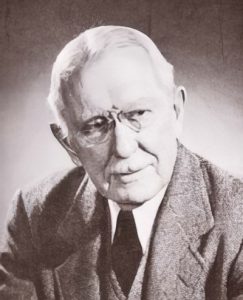
(May 14, 1870-May 18, 1957). Born in Lafayette, Indiana, Bruce Rogers showed an early talent for drawing and penmanship. He entered Purdue University at 16 and decided to become an illustrator, working on several yearbooks, the university catalog and magazine, and an edition of William Cullen Bryant’s . The arrangement of type on paper fascinated Rogers and, after receiving a B.A. degree in 1890, he moved to Indianapolis, working first for the Indiana Illustrating Company, then as an illustrator for the .
Newspaper life did not suit him, however, and Rogers returned to Lafayette where he painted landscapes modeled after those of artist . Later he again moved to Indianapolis, and, in 1893, designed his first published book, Botany In Pharmacy, for . In the title page, initials, and chapter headings for the book of another Hoosier Group artist– Notes of the Walter Collection
Rogers later met Joseph M. Bowles, founder of the periodical , one of the first American reflections of the Arts and Crafts movement. Rogers’ design work in the form of initials and decorations appeared regularly in that publication. Bowles also showed Rogers several early Kelmscott Press books (the famed private press established by internationally known British designer William Morris in 1891), which further aroused his interest in the book as an artifact. The American lithography firm L. Prang and Company subsidized and moved it and Bowles to Boston. Rogers went also, bringing to an end his residence in Indiana but signaling the beginning of a career that brought him international fame.
Rogers became a typographic advisor to Riverside Press (1895-1912), which was established by Henry Oscar Houghton and later became a subsidiary to Houghton Mifflin Harcourt. He also served as an advisor to the Metropolitan Museum Press in New York; the university presses at Cambridge, Harvard, and Oxford; the Press of William E. Rudge. a printer of fine art publications; and Emery Walker, Ltd., another Arts and Crafts Crafts movement printer and engraver located in London. Montaigne (1901) was Rogers’ first type design, but Centaur (1915) was his most famous.
In 1953, Rogers designed the third edition of historian Logan Esarey’s for Indiana University Press. It features his sketches of pioneer tools, implements, and furnishings. One of Rogers’ “devices” carries the words “Bruce Rogers of Indiana,” whereby he acknowledges his roots in the soil that set him on his chosen path.

Help improve this entry
Contribute information, offer corrections, suggest images.
You can also recommend new entries related to this topic.